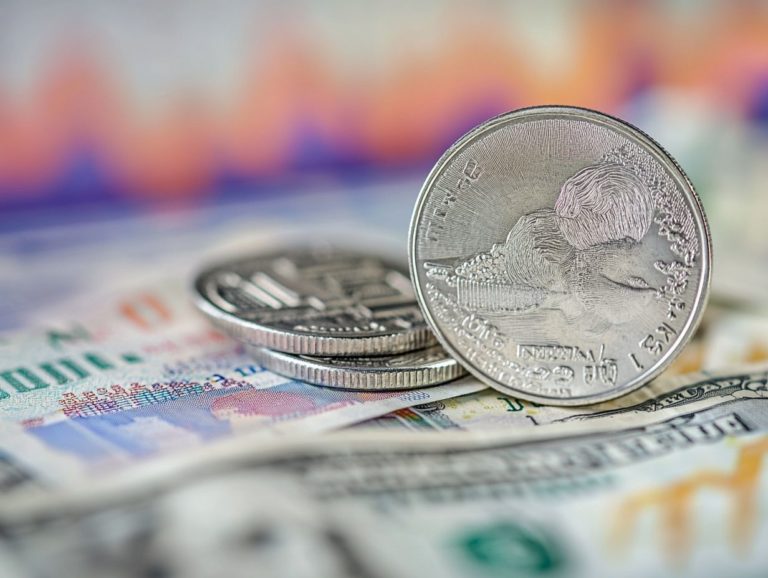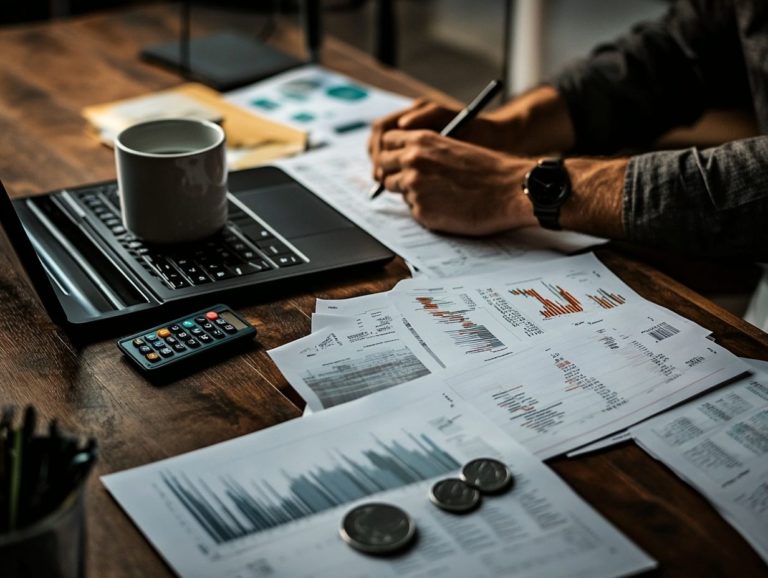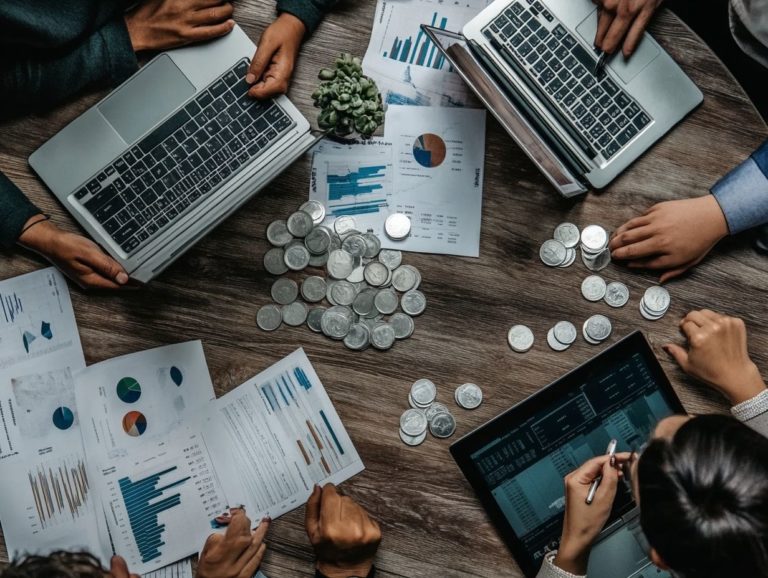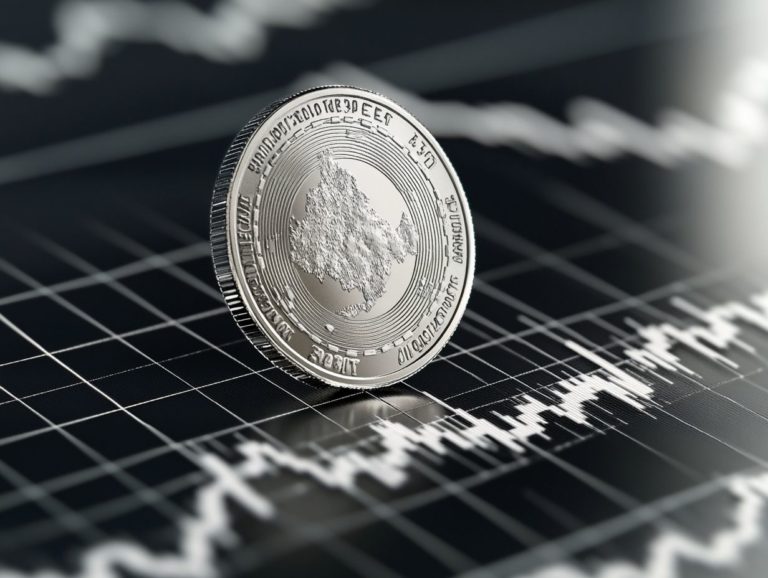The Role of Silver in a Diversified Portfolio
Silver has long been cherished, not just for its beauty but also for its intrinsic value as an investment.
In today s economic landscape, you’ll discover many benefits of including silver in your portfolio. From its role as an effective way to protect your money’s value when prices go up to its reputation as a reliable store of value, silver offers unique advantages that can enhance your investment strategy.
This article delves into the compelling reasons to invest in silver, highlights key factors for your consideration, and outlines practical methods for investing. By exploring these insights, you ll be well-equipped to make informed decisions and unlock the potential of silver to elevate your financial strategy.
Contents
- Key Takeaways:
- Benefits of Including Silver in a Diversified Portfolio
- Factors to Consider Before Investing in Silver
- Your Guide to Smart Silver Investments
- Frequently Asked Questions
- What is the role of silver in a diversified portfolio?
- How does silver perform compared to other assets in a diversified portfolio?
- What are the potential risks of including silver in a diversified portfolio?
- What is the recommended percentage of silver to include in a diversified portfolio?
- How does silver fit into a long-term investment strategy as part of a diversified portfolio?
- Are there tax implications for holding silver in a diversified portfolio?
Key Takeaways:
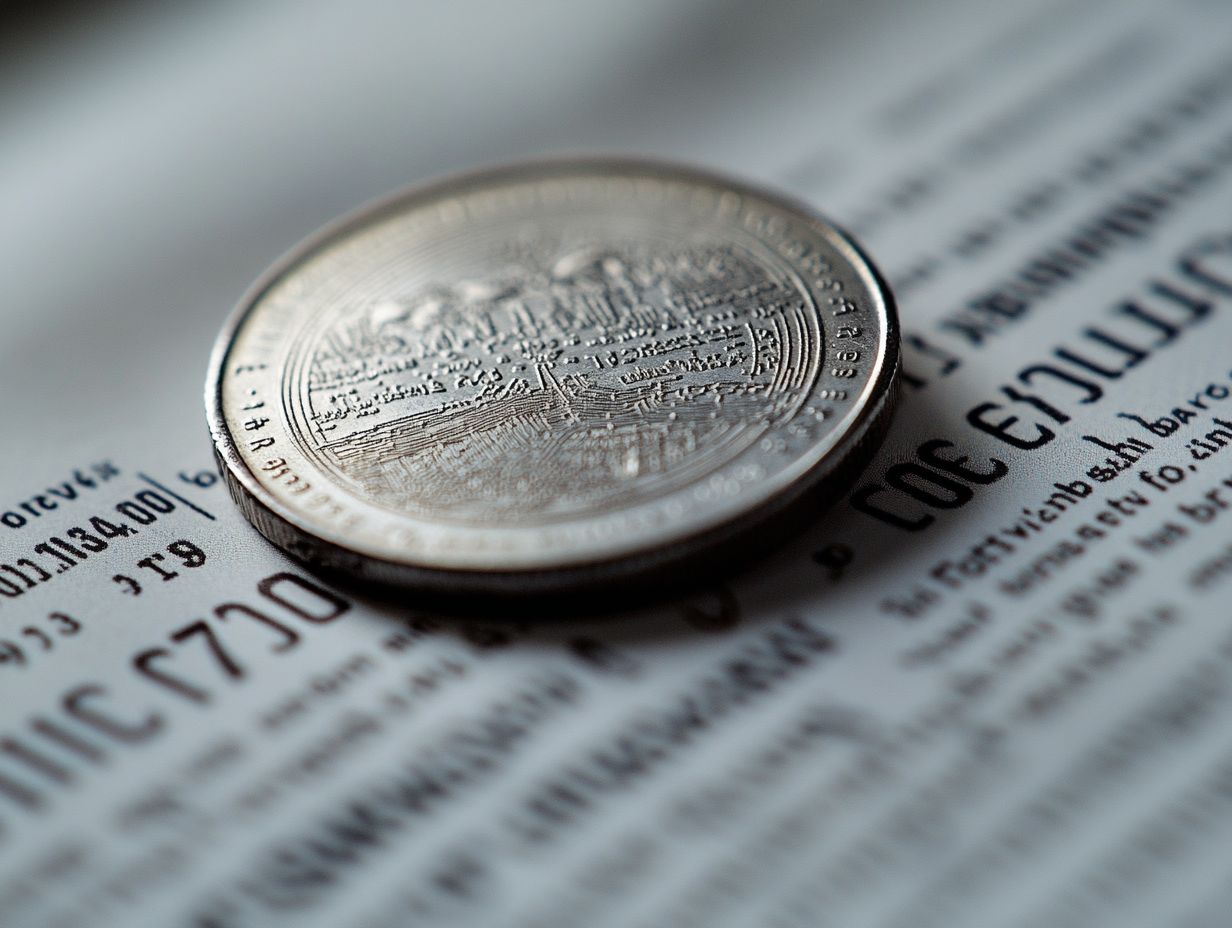
- Silver is a precious metal that holds value and can act as a hedge against inflation, making it a valuable addition to a diversified portfolio.
- Investing in silver provides diversification, stability, and potential for growth in an uncertain market, making it an attractive option for long-term wealth preservation.
- When considering investing in silver, it is important to monitor market trends, understand storage and security options, and carefully manage risk to maximize returns.
Consider adding silver to your investment strategy today!
What is Silver?
Silver, a precious metal celebrated for its industrial applications and aesthetic allure, has been a cornerstone of the global economy for centuries. It’s not just a staple in jewelry and silverware; it plays a vital role in electronics, solar panels, and medical devices, showcasing its versatility as a commodity.
The historical significance of silver, once a form of currency and a means of storing wealth, reinforces its status as a valuable asset in investment portfolios, particularly considering the role of silver in renewable energy.
Throughout history, silver has symbolized wealth and power, often minted into coins for trade and commerce since the dawn of ancient civilizations. Its remarkable antimicrobial properties, which help kill or prevent the growth of germs, make it critical in healthcare, enhancing its appeal across various medical applications.
As industries continue to evolve, the demand for silver remains on the rise, particularly in the realm of renewable energy solutions where its conductive qualities enhance efficiency. With the ever-changing landscape of market dynamics, savvy investors frequently turn to silver as a hedge against inflation and economic uncertainty, solidifying its legacy as both a tangible and financial asset.
Why Invest in Silver?
Investing in silver offers a wealth of options for you as you seek to diversify your investment portfolio, especially in times of economic uncertainty and market volatility. As a safe haven asset, silver typically shines during financial crises, often serving as an effective hedge against inflation that helps preserve your wealth.
This enduring quality makes silver an appealing choice for anyone focused on safeguarding their capital. Historical trends show that during economic downturns, silver often maintains its value better than many other assets, which can lead to potential appreciation when markets eventually stabilize.
By weaving silver into your portfolio, you can take advantage of its unique attributes, fostering a balanced approach to risk management. The increasing industrial demand for silver in technologies like solar panels and electronics adds an extra layer of strategic advantage, creating opportunities for long-term capital growth that extend beyond traditional investment paths, especially when considering the role of paper assets in a diversified portfolio.
Benefits of Including Silver in a Diversified Portfolio
Incorporating silver into your investment portfolio presents a range of advantages that can greatly strengthen your finances, particularly during economic downturns and financial crises.
As an integral component of a diversified strategy, silver harmonizes beautifully with other assets, offering you an extra layer of protection against market volatility and unforeseen price fluctuations.
Inflation Hedge
Silver stands out as a formidable inflation hedge, preserving its value and purchasing power even as costs rise. When the American dollar weakens, savvy investors like you often turn to silver and gold to protect against loss of wealth.
Historically, silver has shown remarkable resilience during inflationary periods. It often outperforms many other commodities in retaining value.
While gold garners the spotlight as the primary asset for hedging against inflation, silver plays a crucial role too. Its industrial applications can drive demand and elevate prices.
Take the 1970s as an example. Both precious metals soared as inflation peaked, showing how effective they can be during economic uncertainty.
This correlation underscores silver’s role in safeguarding capital from unpredictable monetary policy and diminishing purchasing power of fiat currencies.
Portfolio Diversification
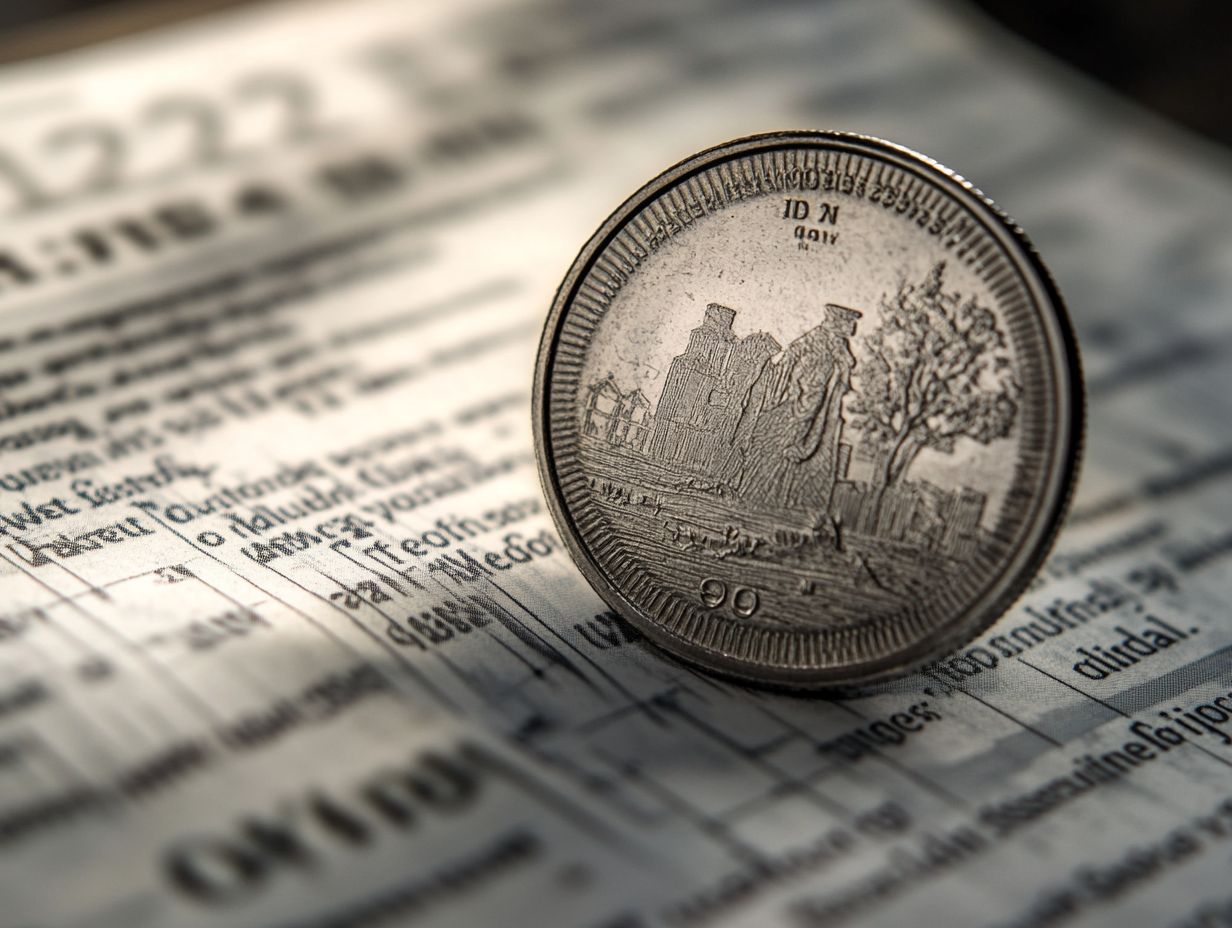
Integrating silver into your investment strategy enhances portfolio Diversification. It allows you to manage risk more effectively and navigate market volatility.
Including precious metals like silver helps alleviate liquidity concerns. You can strike a balance in your exposure to fluctuating market conditions.
This strategic addition smooths out your portfolio’s performance. This is especially important during turbulent times when traditional assets like stocks may falter.
Silver has a low correlation with equities, making it a great hedge against stock market fluctuations. In downturns, its potential for appreciation not only offers protection but presents opportunities for substantial returns.
Its inherent liquidity means you can access your funds quickly without significant losses. This solidifies silver’s role as an essential part of a well-rounded investment approach.
Store of Value
As a store of value, silver is esteemed for its ability to preserve wealth. This is especially true during financial crises and economic uncertainty.
When traditional assets waver, savvy investors gravitate toward precious metals like silver and gold. Historically, silver has shown its resilience during economic downturns.
For example, during the 2008 financial crisis, silver’s price surged as investors sought safe havens. This underscores its status as a reliable asset.
Unlike fiat currencies, which are vulnerable to inflation and government policies, silver maintains its intrinsic value. This quality makes it appealing for those seeking a hedge against inflation.
Across cultures, silver is cherished not just for its beauty but for its practical applications in industry and technology.
Given these attributes, many discerning investors view silver as essential for a well-rounded investment portfolio.
Factors to Consider Before Investing in Silver
Before you begin your silver investment, consider key factors like market trends and the demand for the metal.
Understanding the intricacies of the silver market can greatly influence your investment decisions and potential returns.
Market Trends and Demand
Market trends and the demand for silver are shaped by various factors, including industrial usage, investment interest, and geopolitical events, as highlighted in reports like the World Silver Survey. Understanding these dynamics can provide valuable insights into potential price movements and demand fluctuations.
The relationship between economic indicators, such as inflation rates and currency strength, significantly influences the silver market. During times of economic uncertainty, many people turn to silver as a safe-haven asset, enhancing its appeal.
Silver’s diverse applications in industries like electronics and renewable energy further boost its steady demand. Recent studies reveal that increased investments in solar technology have led to rising consumption rates. This illustrates how shifts in technology and industrial needs can create waves in the global silver market.
Storage and Security
When investing in silver, considerations around storage and security take center stage, especially for those leaning toward physical silver. The importance of secure storage solutions can lead to liquidity concerns, making it crucial to evaluate your options closely to seize every market opportunity that arises!
A reliable home safe provides immediate access, allowing you to act quickly in the market. However, risks like theft or natural disasters can compromise its effectiveness.
On the other hand, bank vaults offer heightened security and professional oversight, but access restrictions may pose challenges to your liquidity during critical moments.
Professional storage services present another viable option. These often come with robust insurance and specialized care, although they may incur fees that could impact your overall returns.
Each storage choice you make carries implications that can enhance or constrain your investment strategy, ultimately influencing how you approach your silver investment.
Your Guide to Smart Silver Investments

Investing in silver opens up exciting opportunities, from owning physical silver to exploring mining stocks and exchange-traded funds (ETFs) like the ICICI Prudential Gold ETF and ICICI Prudential Silver ETF.
Each method comes with distinct advantages and considerations, allowing you to tailor your investment strategy to align with your financial goals.
Physical Silver vs. Silver Stocks
When deciding between physical silver and silver stocks, it s essential to weigh the unique benefits and risks each option presents. Physical silver offers a tangible asset that serves as a reliable hedge against market manipulation. In contrast, silver stocks grant you ownership in mining companies, which can yield higher returns but come with added volatility.
The liquidity of each investment type also influences your decision. Physical silver can be easily bought or sold across various markets, making it a flexible choice for those who may need to convert their assets into cash quickly.
Conversely, silver mining stocks may experience more erratic price movements due to market fluctuations. It s crucial to consider how geopolitical events and economic conditions affect mining companies differently from the physical asset itself.
Don t overlook storage, insurance, and potential dividends; these factors are vital in determining which investment path suits you best.
Buying and Selling Silver
The journey of buying and selling silver requires you to navigate market volatility and liquidity concerns. Stay informed and strategic in your approach. Whether you’re looking to purchase physical silver or trade silver stocks, understanding market conditions can significantly impact your investment outcomes.
To manage these transactions, explore various trading platforms, such as online brokerages or local coin shops, each with its own fees. Timing is everything! By following economic indicators and seasonal trends, you can gain valuable insights that inform your decisions.
Diversifying your silver investments and using stop-loss orders a tool that automatically sells your silver if prices drop too much can help mitigate risks associated with sudden price fluctuations.
By keeping abreast of global silver market news and consulting with financial experts, you can better navigate the complexities of silver trading, ultimately working toward a balanced and profitable portfolio.
Managing Risk and Maximizing Returns
Managing risk and increasing your profits is crucial in the silver market, where price fluctuations can be dramatic. A carefully crafted strategy on how you divide your investments can optimize your overall performance and minimize potential losses.
In this volatile landscape, explore various risk management strategies that protect your capital while enhancing your returns. By diversifying across different asset classes such as stocks, bonds, and precious metals, you can spread your risk more effectively while capitalizing on the role of technology in silver investment and its price movements.
Incorporating assets that do not move with silver can add stability to your portfolio, resulting in a more resilient portfolio. Staying vigilant about macroeconomic indicators and market trends allows you to adjust your strategies dynamically. Understanding physical vs. paper assets in investing can help you navigate potential downturns and seize favorable market conditions when they arise.
Frequently Asked Questions
What is the role of silver in a diversified portfolio?

Silver helps protect your investments from inflation and market swings, making it a valuable addition to a diversified portfolio.
How does silver perform compared to other assets in a diversified portfolio?
Silver has historically shown low correlation with stocks and bonds, providing diversification benefits and potentially reducing overall portfolio risk.
What are the potential risks of including silver in a diversified portfolio?
As with any investment, there is always a risk of loss. Silver prices can be volatile and may not always move in line with the stock market, potentially leading to losses in a diversified portfolio.
What is the recommended percentage of silver to include in a diversified portfolio?
The amount of silver to include depends on individual risk tolerance and investment goals. Experts recommend a range of 5-10% for precious metals, including silver.
How does silver fit into a long-term investment strategy as part of a diversified portfolio?
Silver has historically held its value over time and can provide a hedge against inflation, making it a potential long-term investment option. However, regularly reviewing and rebalancing your portfolio is important to ensure it aligns with your current investment goals.
Are there tax implications for holding silver in a diversified portfolio?
Silver is considered a collectible by the IRS and is subject to a higher tax rate when sold, potentially affecting your overall return on investment. Consult with a tax professional to understand the specific tax implications for your portfolio.










